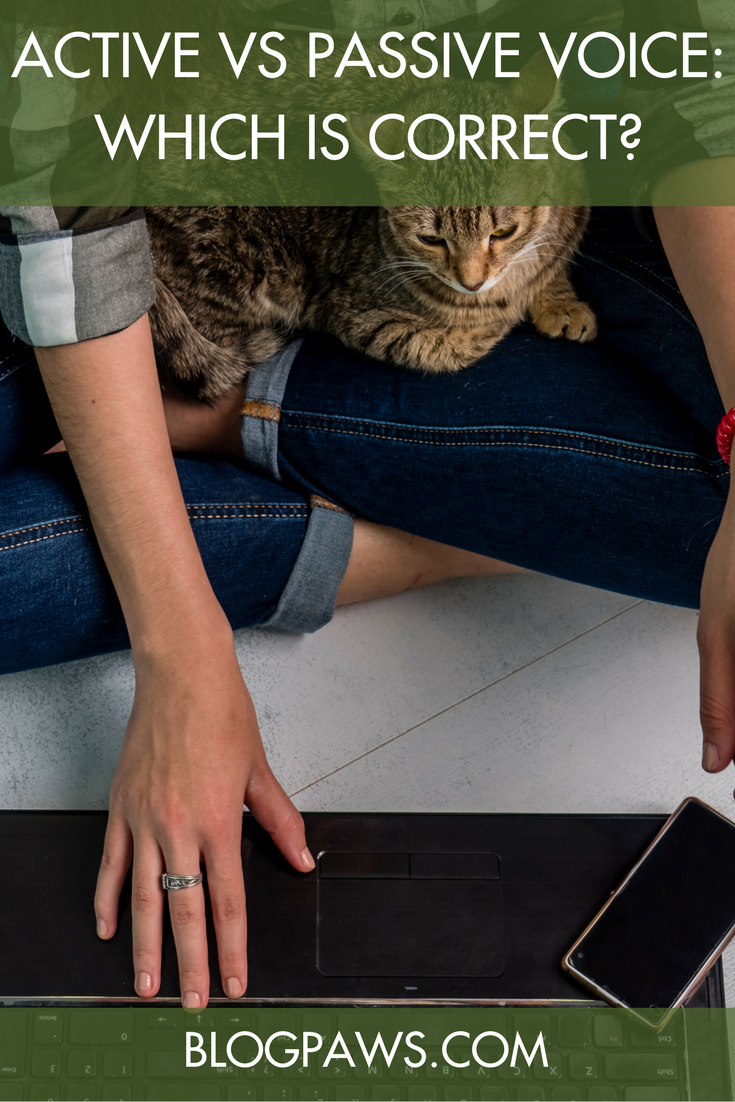Active vs Passive Voice: What Are They and Which Should Bloggers Use?
Any writing advice you encounter probably makes the same recommendation: Use active voice instead of passive voice.
It’s a good rule… but, for those who’ve long forgotten their high school English curriculum, it can be confusing.
What is active voice again?
And how does active differ from passive voice?
And should bloggers use active or passive voice?
Never fear: All the answers are here!
First, some definitions:
According to The Chicago Manual of Style, “Voice shows whether the subject acts (active voice) or is acted on (passive voice)–that is, whether the subject performs or receives the action of the verb.”
For example, if the subject is doing the action, the sentence would read: The vet loves her cat patients.
If it were a passive construction, the sentence would read: The cat patients are loved by the vet.
The Chicago definition continues, “As a matter of style, passive voice {the matter will be given careful consideration} is typically, though not always, inferior to active voice {we will consider the matter carefully}.”
Why?
Active voice is “normal” in the English language. It’s how we speak and tell stories.
Passive voice appeals to young writers who are trying to hit lengthy page requirements for English assignments. Also, passive voice makes some writers feel like they sound “smarter” by writing long, flowy sentences. In reality, the opposite is true.
Passive voice elongates sentences and obscures meaning. We want our readers to understand us, right? So, write clearly and concisely with active voice.
Let’s look at some examples.
Passive voice: The cat was brushed by Kathy.
Active voice: Kathy brushed the cat.
Passive voice: Mistakes were made by the groomer.
Active voice: The groomer made mistakes.
Passive voice: Pet owners were angered by the manufacturer’s refusal to answer for their recall.
Active voice: The manufacturer’s refusal to answer for their recall angered pet owners.
There are some instances, however, when passive voice can’t (or shouldn’t) become active.
For example: “The dog walker was robbed in the park last night.”
Who robbed the dog walker? Since we don’t know, we can’t say. (If, however, we knew that Spiderman robbed the dog walker, we’d say: “Spiderman robbed the dog walker in the park last night.”)
OK, so let’s bring this all together with what I’m calling “the kitten rule.”
If you can add the phrase “by kittens” after the verb in a sentence, it’s passive voice and should be examined for revision.
Passive voice: She was chased {by kittens}.
Active voice: Kittens chased her.
Passive voice: The computer’s hard drive was damaged by the electrical surge {by kittens}.
Active voice: Kittens damaged the computer’s hard drive.
NOTE: In the example above, when you have a sentence that indicates the action was done “by” something already, it’s a passive voice giveaway! That’s why the “by kittens” rule works.
Passive voice: The house was haunted {by kittens}.
Active voice: Kittens haunted the house.
If you try the “by kittens rule” on a sentence that’s already written in active voice, it doesn’t work. For example: Kittens haunted the house {by kittens}. Or: The child squealed over the adorable kittens {by kittens}.
There you have it: passive versus active voice! Hopefully these examples clarified any questions you had. If you have any additional questions or would like to share real-life examples, please do so in the comments!
Additional Resources:
Purdue Online Writing Lab: Active Versus Passive Voice
Grammar Girl: Active Voice Versus Passive Voice
Maggie Marton serves as the BlogPaws senior editor. When not hiking with her two pit mixes, Emmett and Cooper, or playing with Newt the Cat, Maggie writes about them (and the pet industry) at ohmydogblog.com and maggiemarton.com.
Image: yurakrasil/Shutterstock.com






One Comment